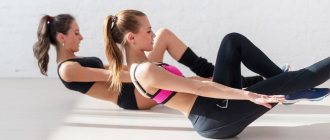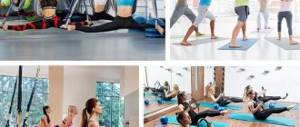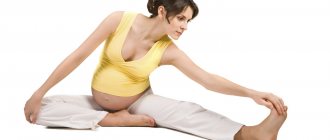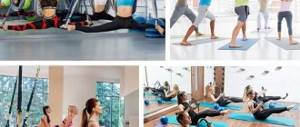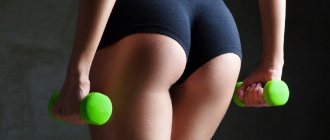Sport
- Benefits of Pilates during pregnancy
- Dangerous and safe movements
- How to deal with expectant mothers
Pregnant women know how important it is to keep themselves in good physical shape. One of the popular types of fitness for expectant mothers is Pilates. This program allows a woman expecting a child to remain active and cheerful, while the complex is safe for the baby.
Benefits of classes
This type of training allows you to strengthen the pelvic and abdominal muscles, joints, prepare for labor, improves your emotional state, and prevents the occurrence of depression. Pilates during pregnancy provides the following benefits:
- relaxes the muscles of the back and shoulder, thereby reducing the severity of pain in these areas;
- prepares the body for the upcoming birth thanks to smooth and measured movements;
- improves blood flow in the legs, thereby preventing the occurrence of varicose veins;
- accelerates metabolic processes in the body;
- maintains correct posture;
- improves the psychological state, prevents the development of depression, neuroses, etc. thanks to group classes with other mothers;
- makes it easier to endure childbirth by mastering proper breathing techniques;
- restores the center of gravity, which shifts during pregnancy, improves coordination of movements;
- allows the fetus to take the correct position.
Regular Pilates exercises will help strengthen your back and improve flexibility and mobility of the spine.
Pilates helps pregnant women stay in shape, improve physical health, relieve pain and improve their mood.
That is why obstetricians and gynecologists allow this type of training for their patients if there are no contraindications to it.
Precautionary measures
Pilates during pregnancy requires following some very important recommendations:
- You can start classes no earlier than an hour after eating;
- all exercises must be performed slowly, smoothly and without sudden movements;
- the exercise with the starting position on the back must be completely excluded from the general training program;
- to eliminate the risk of hypothermia, it is recommended to conduct training on a gymnastic mat or mat;
- eliminate as much stress as possible on the joints during exercise;
- Slow, pleasant music during training promotes a good mood and calmness;
- To eliminate the risk of high stress on the body, it is necessary to perform relaxation activities between exercises.
Limitations and possible harm
Training for pregnant women is somewhat easier, but even despite this, they have contraindications:
- chronic diseases of the cardiovascular and respiratory systems;
- high risk of miscarriage;
- low placentation;
- problems with the musculoskeletal system;
- serious injuries and previous surgical interventions in relation to the spine and joints;
- gestosis;
- increased intravenous pressure;
- severe gestation (with constant toxicosis, swelling, large weight gain).
In addition, there are relative contraindications. It is better to postpone Pilates classes if any illness worsens, even a cold, or if your health worsens. Training can be resumed after recovery.
If you do not take into account contraindications, you can harm your health and the condition of the child (miscarriage, defects and developmental disorders, etc.).
Therefore, when starting Pilates classes, you need to consult with an obstetrician-gynecologist who accompanies pregnancy. The specialist determines individually in each specific case whether pregnant women can exercise.
The nature of classes with expectant mothers should be individual, just like with a trainer in the gym.
Pilates: what is it?
A popular technique was invented by a doctor originally from Germany, Joseph Pilates. The system of gymnastic exercises was actively used for the rehabilitation of wounded soldiers in the First World War. Later, those who dreamed of losing weight paid attention to the technique. Having assessed the benefits of the classes, doctors began to recommend them to expectant mothers.
Pilates is a simple exercise combined with breathing exercises. The main principles of the methodology:
- Relaxation. You need to study “lightly”. Areas that do not work during the exercise should be as relaxed as possible.
- Concentration. It is important to concentrate on doing the exercise and discard unnecessary thoughts. This allows you to carefully work out the areas and avoid injury.
- Smoothness. Only smooth movements are encouraged, no jerks. The workout should take place at an average pace. There is no need to apply excessive force when charging.
- Breath. It is important to learn proper chest breathing: as you inhale, a lot of oxygen enters the lungs, the back opens, as it exits, the lungs are emptied, and the ribs return to their previous position. You cannot breathe with your stomach and strain your abs.
A set of exercises by trimester
Regular Pilates classes are not suitable for pregnant women. Therefore, a special set of exercises has been developed for them, including aerobic exercise, slow and smooth movements. When training, the following rules must be observed:
- start exercising at least an hour after eating;
- movements are measured, without jerking;
- You cannot perform exercises while lying on your back or stomach, with prolonged holding of your breath, tensing your abs, or strong stretching;
- Pregnant women are prohibited from overcooling, so movements that need to be performed on the floor are performed on a special gymnastic mat;
- the load on the joints should be minimal;
- During training, it is recommended to turn on soothing music; it allows you to relax and improves your emotional state;
- perform exercises at least 2-3 times a week; if you skip classes, there will be no benefit from them.
Basic principles of Pilates:
- Full concentration. When exercising, it is important to listen to your body and sensations.
- Centering. Concentrate your attention on the muscle group that is being worked at the moment.
- Control and self-control. You can't make movements as you please. Everything must be technically accurate and correct.
- Breath. It is under control and should be smooth and deep.
- Smoothness. All movements are measured, without jerking.
The exercises will vary depending on what trimester a woman is in. Let's take a step-by-step look at the complexes designed for each period.
The Pilates technique is mastered under the guidance of an instructor, but not independently.
1st trimester
Already in the first trimester, Pilates excludes any sudden movements, jumping, or strength exercises. During this period, the formation of the fetus occurs, so you need to be careful about your well-being during training. There should be no pain after or during exercise. It is strictly forbidden to lie on your stomach, although it is not there yet.
Pilates for pregnant women 1st trimester includes the following exercises:
- Breathing exercises. Feet shoulder-width apart, arms at your sides. Inhale and exhale first through the chest and then through the stomach. While drawing air into your lungs, stretch out to your full height as much as possible.
- Warm-up for the neck. Make alternating tilts with your head left and right, forward and backward. Then make circular movements without throwing the back of your head back. During the exercise, only the head works, the shoulders remain at the same level.
- Gymnastics to increase lung capacity. Feet shoulder width apart. Hands at your sides. Raise your upper limbs to the sides to shoulder level. Take a deep breath. As you exhale, return to the starting position.
- Balance exercise. Get on all fours. As you inhale, extend your left arm and leg, lifting them off the floor. As you exhale, return to the starting position. Repeat with opposite limbs.
- Exercise "cat". As you inhale, bend your back, while exhaling, arch your back. Return to starting position.
- Abdominal exercise. Sit on the floor. Spread your legs and arms to the sides. Perform body turns left and right.
- Movement for relaxation. Sit on your knees, placing your palms on the floor. From this position, move onto your heels, tilting your body forward. During the exercise, the arms are extended, the back is relaxed. The knees should be spread apart so as not to press them into the stomach.
In the first trimester, the risk of miscarriage is high, even in women whose pregnancy is progressing normally. Therefore, it is recommended to do the exercises first under the supervision of a trainer. It is very important that they are performed technically correctly. When the movements are perfected, you can move on to independent training.
The exercises are accompanied by the sound of calm, soothing music.
2nd trimester
In the second trimester, you can perform the same exercises as in the first. Plus, movements are added to this aimed at ensuring that the fetus takes the correct position. For breech presentation:
- Get on your knees, lean on your elbows. Stay in the pose for 15 minutes.
- Lie on each side for 10 minutes. Roll over carefully so as not to put pressure on your stomach.
For transverse presentation:
- Lie on the side opposite the baby's head. Curl into the fetal position. The knees should not be too close to the chest. Lie like this for 10-15 minutes.
- From the previous pose, roll over your back to the other side while inhaling. Straighten your lower leg.
These Pilates exercises do not help you lose extra pounds. Pregnant women do not need this, since forced weight loss can be dangerous for the fetus.
3rd trimester
The third trimester should be as calm as possible. You can perform breathing exercises, but it is better to avoid the rest. If you still decide to continue exercising, it is recommended to stop balance movements, such as the golden rooster standing on one leg. In the later stages, their implementation is not safe.
As it became clear, pregnancy is not a reason to give up physical activity. The most important thing is that it is moderate. Pilates classes are great for pregnant women. The most important thing is to do everything correctly, take into account contraindications, then the exercises will not cause harm. It is better to give up training in the third trimester, however, if the expectant mother has previously been involved in sports, then she can continue them further, excluding some movements. Obstetricians and gynecologists allow women in good physical shape to practice Pilates until approximately 38 weeks.
Postpartum period
After the birth of a baby, women's figures change. They need to correct not only their weight, but also their weakened muscles. Pilates will easily get your mother's body in shape, strengthening muscle tissue and tightening the skin. The complete safety of the technique allows it to be used in the first month after the birth of the baby (as soon as the bloody postpartum discharge ends).
If the birth was carried out by caesarean section, then very simple Pilates exercises will also help restore lost muscle strength in the hips and pelvic organs. You need to start training 3-4 months after the birth of the child. This limitation is associated with the healing of the external suture. In the first month of training, you need to hold the seam with your hand while performing exercises.
A safe and simple system of exercises, if performed regularly, can “work wonders” with the female body at any age. The main thing is to choose the right complex that matches the woman’s condition at the moment.
Basic Rules
As in any other sport or fitness, Pilates adherents have their own rules. These are rather safety rules, compliance with which will help reduce risks and increase efficiency. Therefore, you need to start with their careful study.
- The system does not set an acceptable deadline for starting classes - you can start studying at any time. But it is best to do this, if not when planning a pregnancy, then at least from the first trimester.
- Correctly performed exercises and the effectiveness of the training are indicated by the complete absence of pain in the muscles after training. If it hurts, contact the instructor and together figure out what was done wrong; you may have to reconsider the list of exercises and the load.
- When performing any technique, it is important for a woman to be able to focus on her actions and sensations. It is very important to learn to analyze your feelings during activity. Gradually, the body itself will begin to “tell” how and what needs to be done in order for the benefits to be maximum.
- Pilates completely eliminates power loads, sudden and fast movements, holding your breath, jumping, and abdominal exercises.
- In the later stages, and preferably from the second half of pregnancy, you should exclude exercises that involve training the ability to maintain balance - with a shifted center of gravity, this can lead to a fall.
- The schedule and frequency of classes should be assigned individually, but on average, it is enough for an expectant mother to attend training 2-3 times a week.
Is it possible to practice at home?
Pilates can be practiced at home. There are a huge number of video tutorials on the Internet, among which you can easily find one that suits your level of training.
Don’t forget that when preparing for Pilates, the same rules apply as for other types of fitness - you can’t eat too much immediately before training.
Select an entry in Russian or one that you understand. During the classes, the instructor explains how to breathe, how to concentrate correctly and what points to pay attention to.



